Posted on April 1, 2024 at 3:55 PM by Monet Butler
Andrew Leicester (b. 1948) is the epitome of a public artist. His massive installation of nine public works of art (six sculptures and three floor mosaics to be exact) stationed in the Molecular Biology Building is a testament to his dedication to conveying a “striking sense of place.” When Leicester was commissioned in 1991, he paired with Hansen Lind Meyer, Inc. to seamlessly blend his art and their architecture.
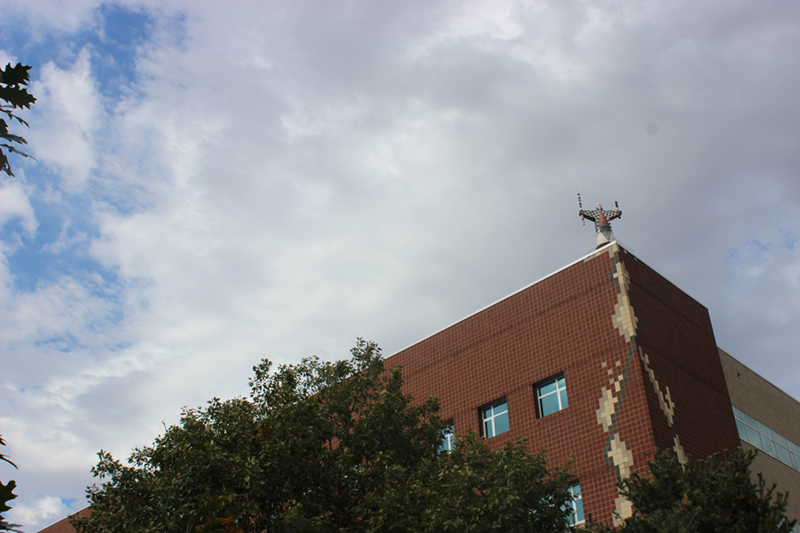 Each installation showcases Leicester’s research on transgenic animals, where one animal, a “host,” has its DNA altered by inserting a foreign genome. At the time of the Molecular Biology Building’s construction, this was a hotly debated topic with serious moral implications. In response to this, Leicester created The G-Nome Project to show the discourse between this breakthrough science and the potential ill-treatment as a result.
Each installation showcases Leicester’s research on transgenic animals, where one animal, a “host,” has its DNA altered by inserting a foreign genome. At the time of the Molecular Biology Building’s construction, this was a hotly debated topic with serious moral implications. In response to this, Leicester created The G-Nome Project to show the discourse between this breakthrough science and the potential ill-treatment as a result.
Stationed at each rooftop corner, the G-Nome sculptures act as guardians of sorts to the entrance of the Molecular Biology Building, quite the imposing sight. Holding the X and Y chromosomes, the guardians wear a stylized coat of black and white checkers or stripes. Not only does this bring the viewer’s mind to crossword puzzles (and therefore the intense problem solving of a new scientific technology), it also symbolizes the marriage of business and science (think a black suit and a white lab coat) which is necessary to develop a new technology. From the bottom of each guardian comes a DNA Double Helix, representative of both the literal scientific process of creating transgenic animals and the mental process of uncovering (and manipulating) life.
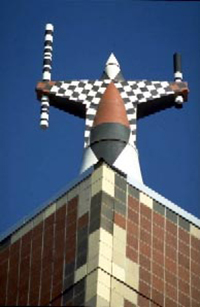
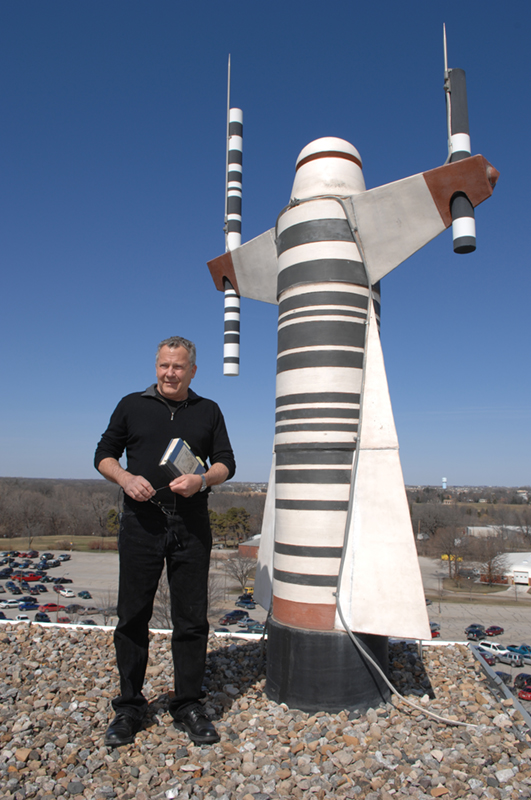
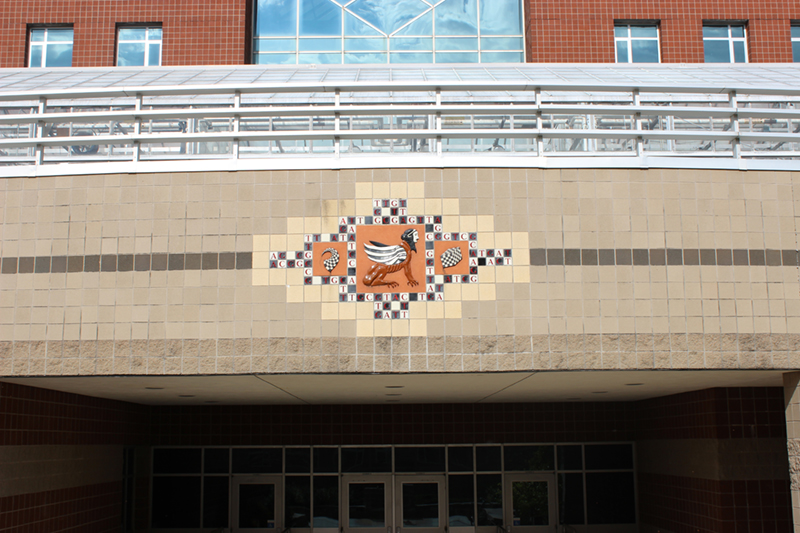 After the viewer makes it into the building through the south entrance, there continues to be a play on DNA sequences. The four relief tiles, aptly named Hy-Brids, show terrifying half-man, half-animal figures that represent the fears of the public of an experiment gone horribly wrong. The center relief is stationed right above the entrance to the building showcases the precarious situation to be faced. One side of a sphinx shows Pandora’s box full of evil and the other a plentiful cornucopia. The message could not be clearer: this research could create unimaginable goodness or unleash unspeakable horror.
After the viewer makes it into the building through the south entrance, there continues to be a play on DNA sequences. The four relief tiles, aptly named Hy-Brids, show terrifying half-man, half-animal figures that represent the fears of the public of an experiment gone horribly wrong. The center relief is stationed right above the entrance to the building showcases the precarious situation to be faced. One side of a sphinx shows Pandora’s box full of evil and the other a plentiful cornucopia. The message could not be clearer: this research could create unimaginable goodness or unleash unspeakable horror.
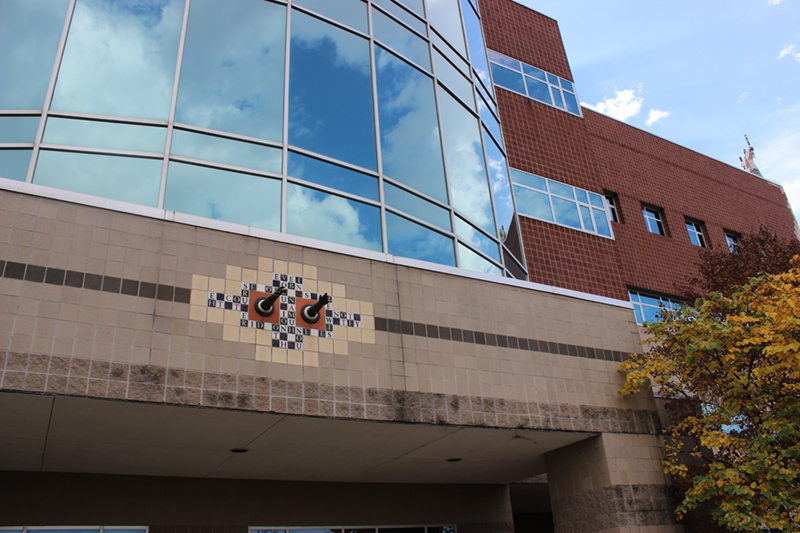 If the viewer chooses to enter through the north entrance, they are confronted with the sculpture Warning-Biohazard. Two black gloves seem to reach out to the viewer, or more generally to the public, as if to use them in an experiment. The hands are highly impersonal and create a sense of a calculative and cold nature, something unfortunately necessary when working with live subjects. Surrounding these gloves are letters that when unscrambled state a warning given by Robert Sinsheimer a renowned biophysicist: “Human beings are not yet wise enough to direct the course of evolution.”
If the viewer chooses to enter through the north entrance, they are confronted with the sculpture Warning-Biohazard. Two black gloves seem to reach out to the viewer, or more generally to the public, as if to use them in an experiment. The hands are highly impersonal and create a sense of a calculative and cold nature, something unfortunately necessary when working with live subjects. Surrounding these gloves are letters that when unscrambled state a warning given by Robert Sinsheimer a renowned biophysicist: “Human beings are not yet wise enough to direct the course of evolution.”
Either through the North or South entrance, the viewer is ushered into the first floor, seeing the first of three mosaic floors within the Molecular Biology Building. Named Gene Pool, this mosaic plays into Leicester’s love of word play. While to a less scientifically minded viewer this may look like a literal swimming pool from above, the mosaic actually depicts the biological process of recombination. This process is when DNA strands are broken and recombined to produce new alleles or mutations. Recombination is the cornerstone of how transgenic animals are created and allows viewers to become a literal part of the process.
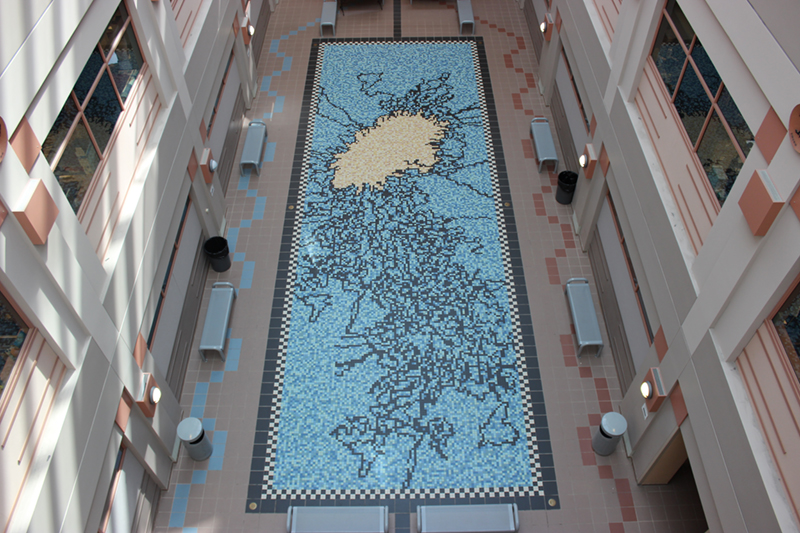
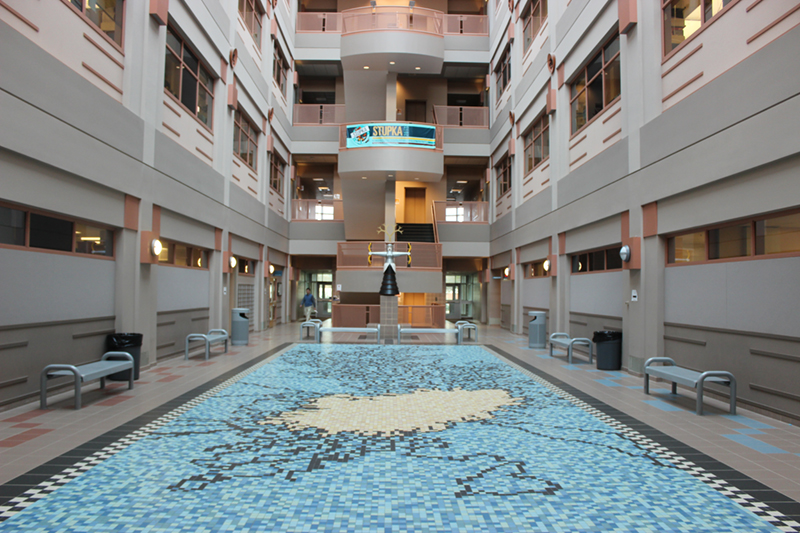
This is by no means the full extent of this massive public work of art. If one has the chance, I highly encourage you to wander the halls of the Molecular Biology Building to see not only the works of art I’ve mentioned here, but the two other mosaics (Conception is Capitalization and Novel Agents) as well as the sculptures Shotgun Method and Forbidden Fruit. For brevity’s sake I won’t explain these thoroughly, but each installation contributes to the masterful story created by Leicester’s interactive storytelling.
Leicester’s multilayered approach to this breakthrough science is both humorous and cautious. Everything is intentional, without a detail missing. His other public art projects are all awe-inspiring and thought provoking, and he is truly an icon within the public art scene, which makes this installation a perfect fit for the Art on Campus Collection.
Monet Butler
University Museums 2024 Pohlman Fellow
ISU Class of 2026 | Political Science
The G-Nome Project, (which includes Conception in Capitalization, Forbidden Fruit, Gene Pool, G-Nomes, DNA Double Helix, Hy-Brids, Novel Agents, Shotgun Method, and Warning-Biohazard) 1991-1992
Andrew Leicester (British b. 1948)
Location: Molecular Biology Building
Commissioned by the University Museums. An Iowa Art in State Buildings Project for the Molecular Biology Building. In the Art on Campus Collection, University Museums, Iowa State University, Ames, Iowa. In the Art on Campus Collection, University Museums, Iowa State University, Ames, Iowa.
(U91.77), (U91.75), (U91.76), (2016.979abcd), (U91.71efgh), (U91.72abcd), (U91.78), (U91.74a-x), & (U91.73).

